
 Good Hair Day
Good Hair Day

 Tari basin, Papua New Guinea
Tari basin, Papua New Guinea

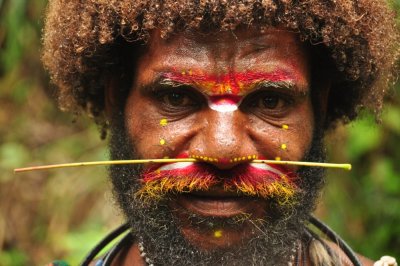
Proud Student |
We had to be ready for our tour at 9 am so we still got to sleep in a bit; toasty warm beds are hard to get out of. I think both of us were very excited. The tour had been arranged and demonstrations had been booked, meaning in the villages we visited people would “dress up” for us. Well not completely. As we saw at the market, that was in no way for tourists, the older generation still dress in the grass skirts, fancy headbands and other bits and pieces but in colder weather add a t-shirt or coat. A few younger guys were dressed up but I think only to please a “grandparent”. We don’t usually go for touristy, fake, shows; they can be awkward for both the performers (usually young people who do it like a part time job at McDonalds) and us. But…here the people we will be seeing are the older generation who up until recently lived and carried on exactly as they will be demonstrating. In fact, some still do live according to those beliefs and customs, although not many.
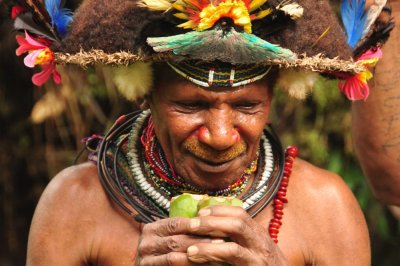
Teacher |
Traditional Huli culture is highly developed and strikingly executed in dress and personal decoration. They wear head bands, bright make up on their faces and, usually, a cassowary quill through their nasal septa. Strands of beads, shells, seeds and bits of bones with large pieces of Kina shells, random animal teeth or even shiny bits of metal or dart ends attached are hung in layers around their necks, arms, legs and over feather & fur head pieces. They are very fancy and I honestly had troubles figuring it all out. Huli men also wear decorative wigs made from human hair. The wigs were normally their own but as the tradition dies out more men just buy them from other Wig Men. Wig Men can’t grow wig hair after their married, or even if they’ve had “relations” with a woman. It’s only for bachelors.
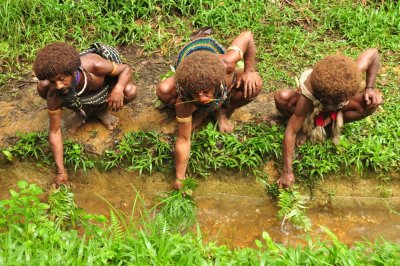
Spring water is the secret |
We are told normal people cannot grow a wig. Cannot or not supposed to, I couldn’t figure that out. To grow a wig you need the special spells from the teacher, follow his strict diet, sleep as he tells you and pretty much anything else he thinks of. Like the three times daily watering of the hair. All the students line up alone the spring with the teacher at the front of the line. He has some leaves and chants and casts spells on the water, I think asking the spirits for help. The students bend over and splash the spring water on their hair. Then they stand up and drink from a bamboo shoot, spitting half the water in the air (and on me and my camera) so it lands on their hair. They can’t wash or comb out their hair while it is growing but can use a long “fan” comb that looks like a chop stick to scratch or pick out the lice and/or bugs. Gross!
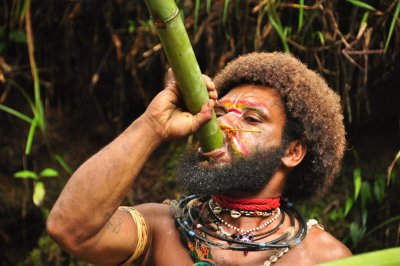
Not sure I'd drink from it though. |
After the watering of the hair demonstration we went up to meet the specialist. He was in charge of cutting it and making it into a wig. There are two kinds; everyday wigs and ceremonial wigs. Everyday wigs are for (duh!) everyday use and if sold go for 600-700 Kina ($300-350 CAD).
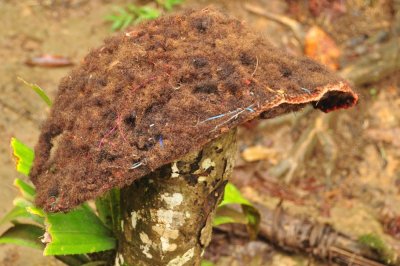
A finished Wig |
Oh and the wigs can never be touched by women or children and if a women is on her period she can’t even come near it. And what will happen? The weather turns from sunny and warm to foul. Blame it on a woman, typical of men!
Some of the ceremonies
(Click on picture for link to videos, appx. 15MB, 15MB, 10MB, 2MB)
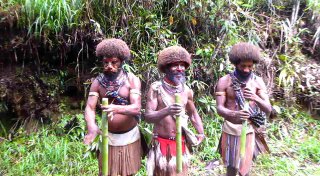 -
-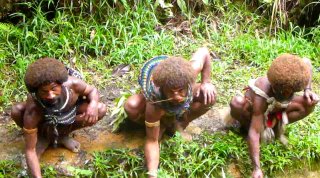
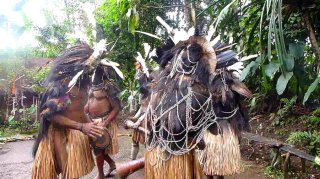 -
-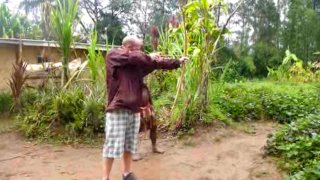
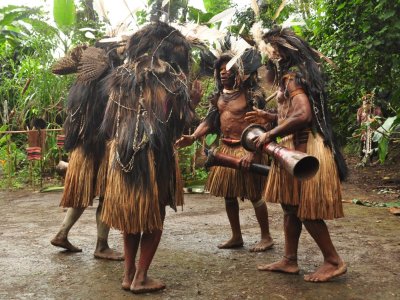
Fancy Dance |
Like at the wig men demonstration (and the others today) they start with a formal welcome. They thank us for traveling all the way to their village, spending lots of money (you’re not kidding there) and taking the time to visit them. This guy explained that other villages around PNG have lost most, or all, of their traditional customs but thankfully Tari gets visitors who are curious and come to visit helping them to keep theirs alive.
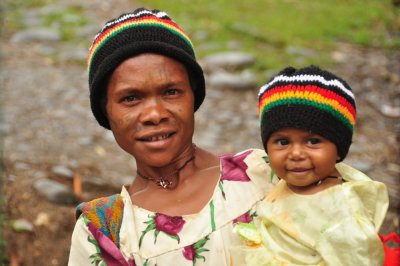
Friendy Faces |
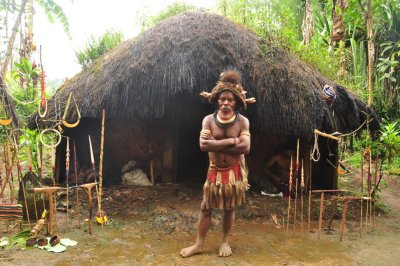
Stop! No Females! |
After lunch we headed back out to the main road and we turned onto a side road. I had a laugh when the driver turned and apologized for the bumpy road. As opposed to? We haven’t seen a smooth driving surface since crossing the PNG Indonesia border. Cute.
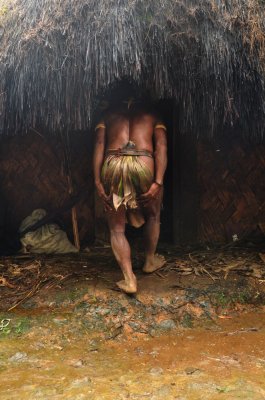 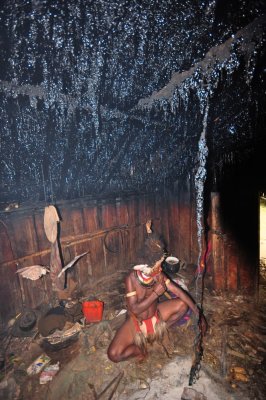
A little drafty in back? And inside the mens tent. |
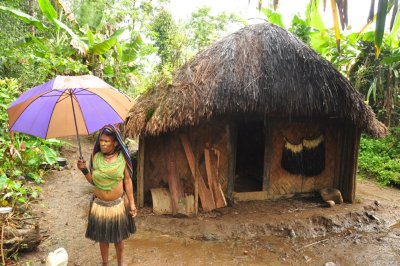 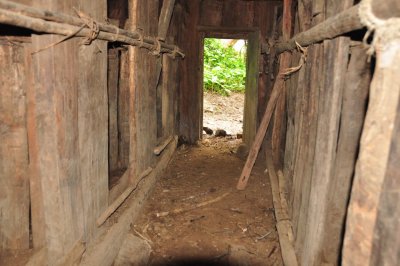 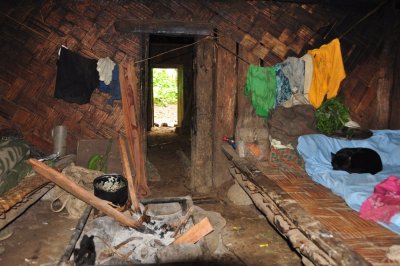
The women's hut, where the pigs live and the front secion where they live with the kids...and kittens. |
After the women’s hut we headed further into the yard. It was beautiful with paths between the mound gardens and fruit trees dotted here and there. I’d say if there was a proper house with a modern toilet in here somewhere I could move in…without the pigs. The chief (I’m not sure what to call him) gave us a demonstration of how to use a bow and arrow and James took a turn. A few ladies and a curious, young naked boy had by now joined us. I seriously think they are as curious about us as we are of them.
We headed still further in to where the medicine man hung out. He’s not the type who is any sort of doctor or helps or heals; in short he gives new couples the birds and bees talk. Everything to do with “relations”, as Steve puts it, is kept very secret. Steve even admits after spending 14 years working in Port Moresby he still had no idea what men and women did together once married. Once married they work until they can afford to buy a pig for the medicine man then go visit him. A few family members come along (for morale support?) and they cook the pig and eat it all, including the fat; especially the fat.
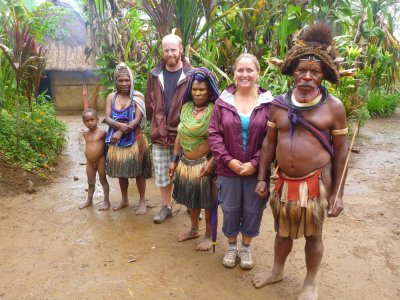
Feeling a little over dressed. |
31 pigs? As we’ve been told – no pigs, no wife! The bride price is what a man must pay for a wife. The 30 pigs (10 big, 10 medium, 10 small) goes to the family and the last one (big) goes to the mother as compensation for her breast feeding her. Honest, I couldn’t even begin to make that up. The marriages aren’t always arranged by the families but they have to agree to it. If you can’t come up with your 31 pigs then usually your relatives will all pitch in. The bride’s family usually gives you a few months to gather them up. If, as Steve put it, nature makes you do something you aren’t supposed to do then the bride’s family will make you marry her and come up with the 31 pigs. If you can’t, in the time given, they cut down your trees or burn your stuff.
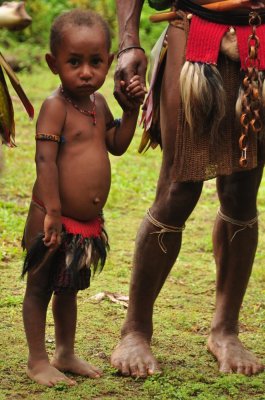
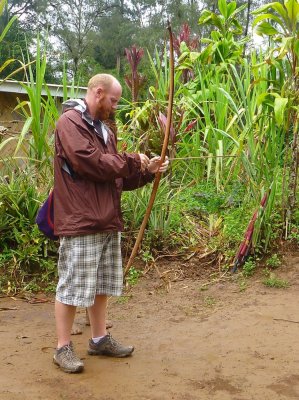
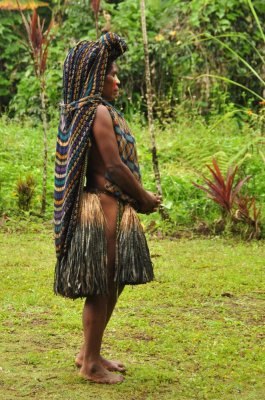
A little cutie! A big cutie! And common women's clothing
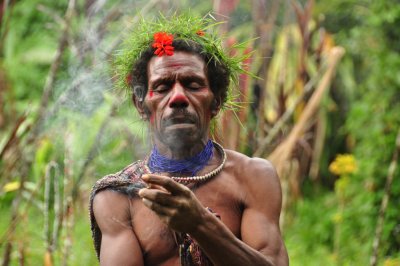
Looks like the medicine man has had a bit to much to smoke. |
Leaving the little village we passed a man, with his family, carrying a gun. James asked Steve what he would be hunting for. Not hunting, we were told, self-defence. His tribe had killed someone in another tribe and they would be out for vengeance so he carried it to protect his family. He was expecting trouble. Deep in thought we headed home. (James’ Note: I don’t think I would last long in a society where your life was at risk anytime a sibling did something dumb)
Getting out of the car we realized our PNG Lonely Planet had been stolen. I had asked Steve if it was safe to leave it in the car and was told yes. Guess not. We had a copy on the computer so it was really no big deal, just inconvenient. We were just pissed knowing that it would be of no good to the thief and he likely couldn’t even sell it. We are realizing this isn’t an area many backpackers visit. It was likely on the side of the muddy road before we even noticed it was gone. For the rest of the day we hung out in the main Lodge enjoying the fire and view.
Over the last two days we’ve talked with people at the lodge, Steve and read some articles about the Tari area and PNG as well. I thought I’d just lump it together for easier reading. Please keep in mind all this information is second hand and might be a little off or outdated.

I didn't know Blaine & Barry did bridges as well as docks! |
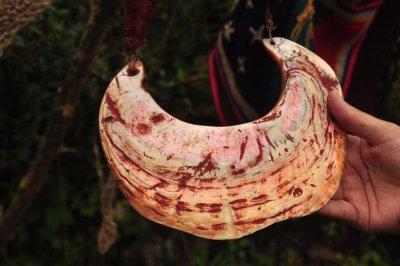
About $100 CAD worth of Kina shell. |
James’ Lengthy Note: I figure the highlands are interesting enough to include my own impressions along with Susan’s. Having been entirely isolated up until 80 years ago, the different areas are in various states of adapting to the rest of the world. The Southern Highlands is the area that has stayed closest to their traditional lifestyle, but it is clearly changing. Watching the video of the first arrival of white men, you can see that within a short while they had incorporated things like discarded Kellogs boxes, and tin can lids into their fancy ceremonial dress, which shows it isn’t exactly the best parts of outside culture we bring with us. When you see the basic huts and gardens, there are definitely some other things that haven’t changed much in the past century for most of the people in this area. There is an obvious spectrum from the older people, many of whom still mostly live the way they would have before intrusion from the outside, to the young people who seem to limit themselves to a little fancy headdress. I figure within a generation the traditional ways will be mostly gone, reserved for the rare special occasion; this is the case with most the rest of the highlands. Even the spirit dancers we saw told us that most villages/clans no longer practice it…but if someone gets sick, etc. they will hire them to perform. I feel very lucky to see this slice of culture before it disappears. The mud men in Goroka (a later Susan blog entry) is how I imagine the Huli in another generation, very similar to aboriginals in North America, where for the most part the traditional way is passed on to remember it, not necessarily to practice it. Although when you hear that even the Christian pastors have a few wives, maybe there is still a ways to go. Other side note- in our trip we passed through many villages without power but we kept seeing cell phone towers, which seemed odd. Until one rest break on the PMV when I noticed that the cell phone company would have a little shipping container/office with a small generator where the locals could charge their phones (for a small fee of course). It is humbling to realize that there are senior citizens in rural Papua New Guinea wearing clothes made of the same grass as their house that are more technologically advanced than me when it comes to phones. I think this speaks volumes of the quality of service that bell canada and rogers have made available to me.


